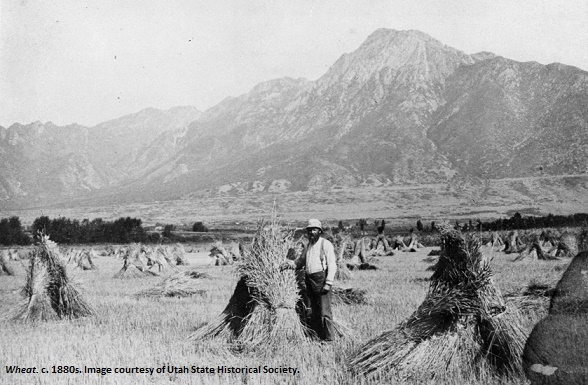Dublin Core
Title
Description
Adequate water for crops proved to be a challenge for settlers throughout Utah. Those in Box Elder County established a strong dry-farming practice, due to inadequate water supply.
When the Mormon settlers arrived in Utah, they immediately planted potatoes and diverted water from City Creek to water them. Coming from lands where crops were usually watered by plentiful rainfall, they saw the need for irrigation, and much of their early effort was devoted to digging ditches and diverting streams.
In about 1866 the Danish settlers of Bear River City in Box Elder County planned to do the same thing, but they soon discovered that the water from the Malad River was so alkaline that it killed the crops and ruined the soil. John A. Widtsoe, director of the Utah Agricultural Experiment Station, wrote about their plight in his 1911 book on dry farming: “In desperation the starving settlers plowed up the sagebrush land, planted grain, and awaited results. To their surprise, fair yields of grain were obtained, and since that day dry-farming has been an established practice . . .” John Wesley Powell also wrote of this event in his 1878 book on the arid lands of the West. He also mentioned an ongoing dry farming enterprise in an area south of Ogden known as the Sand Ridge. There, in the mid-1870s, Christopher Layton grew winter wheat with dry farming methods and reported a yield of ten to fifteen bushels of grain per acre, a respectable harvest for unirrigated land. Powell wrote, “This success is regarded by some of the older settlers as temporary and delusive, for it is said to have depended on exceptional spring rains; but the majority of the community have faith in its permanence, and the experiment is being pushed in many valleys.”
After this, dry farming became the subject of much experimentation throughout Utah. The legislature appropriated twelve thousand five hundred dollars in 1903 for six experimental dry farms throughout the state. Dry farming continues to be an important type of agriculture in Utah.
Creator
Source
Image: Wheat. Wheat field located on Christian Christensen farm c. 1880s. Dry farming became a useful technique throughout the state. Courtesy of Utah State Historical Society.
_______________
Terry Ellis, “Dry Farming in Utah,” Utah History Encyclopedia; John Wesley Powell, Report on the Lands of the Arid Region of the United States with a more Detailed Account of the Lands of Utah, edited by Wallace Stegner (Cambridge: The Belknap Press of Harvard University Press: 1962, originally published in 1878); John A. Widtsoe, Dry-Farming: a System of Agriculture for Countries under Low Rainfall (New York: Macmillan, 1911, 1920).

